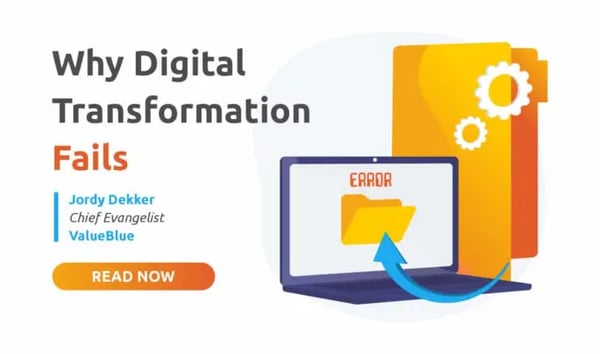Digital Transformation Often Fails – Here’s One Important Reason Why
 As much as everyone would want to, not all digital transformation initiatives are a success. Some don’t deliver the right results, take much longer to complete, or go way over budget. Why is that?
As much as everyone would want to, not all digital transformation initiatives are a success. Some don’t deliver the right results, take much longer to complete, or go way over budget. Why is that?
Jordy Dekker, Chief Evangelist at ValueBlue, shares his insights on the four most common pitfalls, and what you can do to make your digital transformation run smoothly and effectively.
Managing accelerated transformation
In his eBook, Jordy explains how he has seen his fair share of transformation initiatives. Over the last 20+ years, he has contributed to multiple digital transformation programs as Lead Enterprise Architect and transformation advisor. Since the digital age, transformation initiatives have been part of organizations’ growth strategies. Technological innovation resulted in newfound opportunities to identify and fill market gaps, adopt and improve ways of working, and efficiently increase the audience reach.
These developments suddenly skyrocketed as a result of COVID-19. McKinsey even stated that the grocery e-commerce landscape in North America alone accelerated by three to five years in just a matter of months when the first lockdown was introduced in 2020. Organizations had to quickly adopt to new ways of driving business, more dependent on remote services and digitalization.
Having to abruptly transform operations is no small feat, especially if digital transformation hasn’t been on the top of the agenda before. And as was to be expected, some organizations dealt with that better than others. However, the interesting thing to notice was that Jordy identified the same kind of pitfalls in this two-year period as he had in the many years before COVID-19. There are four common factors that hamper and even completely block the successfulness of a digital transformation initiative. In his eBook, Jordy goes into more detail for all of them, but this blog will highlight the first pitfall: setting the right goals and measures.
Goals and measures
With the vast number of opportunities that come with digitalization, it’s important to have a clear view on the company vision and long-term business objectives. This is required to understand where the digitization and digitalization opportunities can be leveraged. That sounds somewhat straightforward, but this pitfall is more common than you might think. Digital transformation initiatives are often seen as stand-alone projects to improve a certain aspect of the organization. This happens when an initiative is started as a solution to a single problem, for instance. The goals are then set based on the single issue to solve, but are often not aligned with the overall goals and objectives of the organization as a whole.
Such an approach increases the risk of a failed project as it does not (fully) reflect the objectives every other department and project is working towards. This can make it harder to attract and engage stakeholders, for instance. Or the initiative is only effective for a very short time as it has not been aligned with the long-term organizational goals, and has to be revisited too quickly.
How to align on goals and measures
So, what can you do to avoid this pitfall? How can you align on goals and objectives early?
Firstly, take the time to identify the long-term objectives and roadmap of the organization. This will provide insights into the key areas where your transformation initiatives are most needed. Does it align and contribute sufficiently?
Second, It’s vital to reflect the organizational goals in the transformation initiative. This will help create more support and need for your program, making it easier to get stakeholder approval. Additionally, it helps build the path for more long-term effectiveness of the initiative, as you can be sure it stays relevant as the company grows.
Thirdly, determine the ways in which you can measure the progress of the transformation initiative. Include multiple moments in the planning to reflect on the effectiveness to make sure you are still on the right track. This is especially important for long-standing transformation initiatives, as the organizational focus can shift as well. Continuously measuring the alignment between the program’s goals and the organizational goals will drastically improve the chances of a successful transformation program.
All transformation pitfalls
Of course, determining and aligning the correct goals and measures is just one aspect needed for a successful digital transformation program. Are you interested in reading all of Jordy’s insights on transformation pitfalls and how you can avoid the same mistakes in your digital transformation programs? Read Jordy’s full eBook here:
.png)



